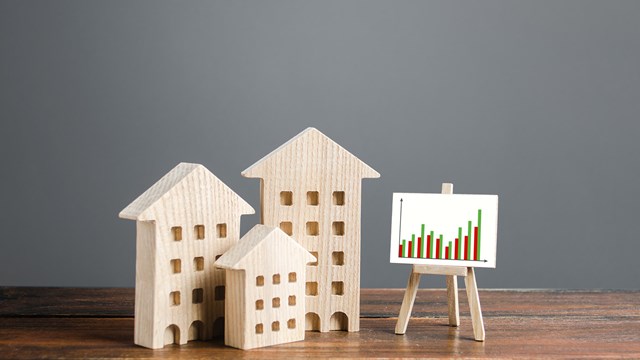If you've noticed a lot of new scaffolding and safety netting going up throughout the city, you may be onto something. 2003 and 2004 are setting up to be substantial years for new residential development.
The very nature of development is a lengthy process that takes many steps - and sometimes many years - to complete, making it difficult to determine exactly why development may be on the rise from one year to the next. But low interest rates, high prices for rentals, and the increasing desirability of nearly every neighborhood in New York City all seem to be contributing.
In a city like New York, different areas are experiencing different types of development and at different rates. "Last year, there were approximately 5,000 new residential units added to Manhattan south of 96th Street," says Charles Singer, director of market research for Rockrose Development, a development company in Manhattan. "This year we're looking at between 5,000 and 6,000 so it's comparable to last year."
Meanwhile, parts of Brooklyn are experiencing a building boom, according to Christopher Thomas, a realtor with William B. May in Brooklyn. "After a long period of watching new residential developments go up in Manhattan without many developments being undertaken in Brooklyn, there's starting to be quite a bit of development locally."
New Additions to the Skyline
No discussion of new construction in the city would be complete without a mention of the new Time Warner Center at Columbus Circle, on the southwest corner of Central Park. The 77-story, 100,000 square-foot, two-tower behemoth contains high-end retail shops, four restaurants, a gourmet grocery, full-service health club, theaters, and a new luxury hotel, the Mandarin Oriental. The Center also includes some of the most desirable - and most expensive - residential real estate in the city. Condos in the south tower have the address of One Central Park, while those in the north tower have been dubbed the Residences at the Mandarin Oriental.
The condos at One Central Park start at $1.5 million and go up to $36 million for each of the two penthouses. One 12,500-square-foot penthouse spanning the 76th and 77th floors was reportedly been sold to a London financier for $45 million - the largest residential deal in the city's history.
If that weren't opulent enough, according to Time Warner promotional materials, the average price per square foot for a condo in the Mandarin is $2,800 - about quadruple the Manhattan average. There are 66 residences in all, starting at around $3.6 million apiece, and 60 percent of the units have been sold. One 1,100-square-foot apartment went for a reported $4.6 million.
While the Time Warner Center is arguably the biggest new construction news of 2004, it's certainly not the only game in town. Rockrose Development has two major developments in the planning phases and while both are rental buildings, the projects give an indication of where residential building in the city is heading.
According to Singer, one big project in the works is a building at 2 Gold Street in Manhattan's financial district. Designed by Avinash K. Malhotra Architects, the 51-story, $200 million-plus Gold Street building is going to be the tallest residential tower in the financial district and will feature 650 units. The tower will be built on a downtown site that comprises approximately 650,000 square feet, occupying most of the block bordered by Maiden Lane and Gold, Platt and Pearl streets.
While Singer says it's too early to get into rental prices, he said he expects the prices to be typical for the area. "It's for young singles and couples who work downtown," he says.
On the opposite end of Manhattan Island, participating in what is quickly becoming a new Harlem Renaissance, is the new 170-unit Strivers Gardens complex, slated for completion in late 2004. Located at West 135th Street and Frederick Douglass Boulevard - one block from City College of New York and half a block from the new-and-much-improved St. Nicholas Park - the building will feature 37,000 square feet of retail on the ground floor, a 24-hour doorman and concierge, an attended parking garage, an in-house gym, a laundry facility, and meeting rooms. One-, two-, and three-bedroom condos in the building range from around 700 to 1,182 square feet and start at around $140,000, with minimum and maximum allowed incomes for applicants to insure that the Gardens remain accessible and affordable for their intended owners; middle-income families.
The New West Side
There has been much talk, speculation, and controversy over the city's proposed overhaul of Manhattan's Far West Side, often referred to as Midtown West or the Hudson Rail Yards. Proposed plans have included everything from sprawling new park space to a much-expanded Jacob K. Javitts Convention Center to an entirely new sports and entertainment complex that could accommodate more than 100 major events per year and would include a home football stadium for the New York Jets - and possibly, some of the 2012 Summer Olympics.
According to city estimates, if the proposed developments get green-lighted - and attract the projected commercial interest - there could be as many as 443,450 jobs brought to that area of the city by 2025.
Development of Midtown West, while exciting, is not without its hurdles; at the moment, subway access stops at 8th Avenue, making Midtown West something of a hinterland for commuters. An expansion of the 7 line would be necessary before the area could truly realize its potential - and the structural and logistical problems of digging new subway lines is a staggeringly difficult, not to mention expensive, proposition. According to a study by the city, the plan to expand the Javitts Center and make the proposed New York Sports and Convention Center feasible would call for the expansion of the 7 line with major stops at 34th Street and 11th Avenue, as well as at 41st Street and 10th Avenue. No small undertaking.
On top of that, long-time residents in the area aren't thrilled with the idea of having sports stadiums and office towers in their backyard and have showed up to voice strong opposition to many of the proposed changes to the area at several public forums hosted by the city to discuss the matter.
Nevertheless, According to Gregory Heim, director of research and chief economist for Terra Holdings, a Manhattan-based development and brokerage firm, "I think that most people will reserve judgment until there's transportation. Some people may not like the 7 train coming over there, and the Jets playing there, and the Javitts Center expanding, and however many million square-feet of new office space being built, but once the transportation is there, and office development begins, I think people will want to live there."
Heim cautions people not to get too excited - or upset - about the proposed developments. "It'll take a few years - even the most optimistic scenario doesn't have anything really happening there for a while. The first thing they need to do is extend the 7, and move Penn Station, build a platform over the rail yards that are over there now, and get the Olympics. A lot of it won't be decided for at least a couple of years."
Be as that may, Heim continues, the development of Midtown West is practically inevitable, given the extremely limited amount of building space in Manhattan and the rise of neighboring areas like Jersey City and Hoboken as both commercial and residential centers in their own right.
"As the commercial developments and transportation improvements begin in those areas, we can expect demand for housing to improve," says Heim. "It'll be interesting to see how they even out; how much commercial mass you have to build before people start putting up condos. It's a similar thing to what happened when they converted a lot of that obsolete office space in Lower Manhattan to residential."
Of course, all this dreaming and planning is free; it's making the dreams and plans a reality that's going to cost, and cost a lot. "It's very expensive to build housing in Manhattan," says Heim, "so will developers be able to get financing to build? It's hard to say: that's an issue throughout the city. Developers' ability to build affordable housing is something that we'll just have to wait and see on."
According to the original study on the issue published by the city, funding may not be quite the Herculean task it seems at first blush. The New York Sports and Convention Center is designed to pay for itself. To sweeten the pot for potential private investors, the city has proposed financing mechanisms, including a system of tax-based initiatives and zoning bonuses which would fund infrastructure investments based on the value of new development without competing for funding with existing public capital agency programs. But for now, at least, the Midtown West plans are in their infancy, says Heim. "The Far West Side is what some people might call the last frontier of Manhattan - you don't have an area that's that undeveloped, that close to Penn Station."
Not to be outdone, but there are some major developments going on in Lower Manhattan's West Side, as well. Downtown on the Far West Side, you have the Greenwich Street project, the brainchild of developer Jonathon Carroll and Dutch architect Winka Dubbeldam, a six-story loft style condominium development where units are going from $1.2 million to $7 million; noted architect Richard Meier's twin glass-towered luxury 28-unit condominium at 173 and 176 Perry Street; the 129-unit loft and townhouse-styled Morton Square development at 171 Christopher Street, which is being developed by Jules Demchick and designed by award-winning architect Costas Kondylis; and the Soho 25 condominium, which is slated to open this spring, with units ranging from $1.1 million to $4.5 million for spacious penthouses, to name a few.
Building in Brooklyn and Beyond
Another part of town that's playing home to a swarm of new activity is Brooklyn. Among the projects being built in the borough Mr. Kotter was welcomed back to many years ago are three in DUMBO (Down Under Manhattan Bridge Overpass), a project at the former school board headquarters in Brooklyn Heights, and another project across the street from that. There are also new multi-family communities planned for the Cobble Hill and Carroll Gardens sections of the borough.
"It's a lot," says Thomas. "And it's a lot relative to what the density of available residential properties has been. So I won't say the market is being flooded, but to use DUMBO as an example . . . prior to 2003, in terms of legal residential occupancy, there were essentially only two buildings in DUMBO in which you could reside. During 2003, that number has more than doubled. Over the next two years, you're probably going to see that number double again just in terms of future contemplated buildings in that area."
But Thomas adds that there's a demand in Brooklyn that coincides with the construction. The borough is more affordable than Manhattan and its communities, with plenty of restaurants and cultural attractions making it a draw, especially among young people. And since so many people who grew up in the suburbs had parents who grew up there and spoke fondly of the area, there's a unique lure to Brooklyn. One only needs to look at the potential move of the NBA's New Jersey Nets to the borough to see how hot a community it has become.
"There is a considerable increase in housing, but the truth of the matter is the demand in these areas has been very strong over the years," Thomas says. "What happened in Manhattan, I think, is that in the late 1990's into 2000, there were a lot of market-rate rental buildings that were built in downtown Manhattan and eventually they hit a wall. The rents just could not continue to go up and up and developers found themselves with rental buildings that weren't completely occupied.
"We had some fallout from that over here [in Brooklyn]," he continues, "but so far, there's no indication that there's a similar overbuilding in this market place." He points to a community called The Arches in Cobble Hill that is 60 percent sold and is expected to be sold out by the spring.
"Those are large units that are selling at prices that range between $500 and $700 dollars a square foot, which is really top of the market for this area."
Another hot spot is Long Island City, in Queens. According to Singer, his company has got a major project going up on the East River, where the old Pepsi bottling plant used to be. The exciting part of this project, according to Singer, is that the building is just one part of the development of what promises to be the newest "hot" neighborhood that happens to not be in Manhattan.
"We think [Long Island City] is going to be the next great neighborhood for New York because it offers easy access to Manhattan without the hassles," Singer says. Straphangers need only take the 7 Train one stop to get to Grand Central Station from the complex.
"It's a long-range development," Singer says of the Long Island City project. "We're looking for the first building to come on line in 2006. There are 3,200 units in development, and it will feature magnificent East River and New York skyline views."
According to Singer, the seven new apartment towers will replace the old bottling plant, but the famous 120-foot red Pepsi-Cola sign with its 50-foot soda bottle - built in 1936, visible from Manhattan, and an unofficial landmark - will be saved.
Aside from the signature sign, Singer says the project will be distinct in other ways. Instead of constructing the new towers out of plain old masonry, the multifaceted facades will each be different, incorporating iron grids and an array of colored brick. Upon completion, the project will have 3.5 million square feet of space - including a large middle school - and nearly two-thirds of the acreage will be open space, including parks, landscaped areas, streets and sidewalks.
Other factors that make Long Island City attractive is that it has drawn many people from the art world (the Museum of Modern Art has temporarily located some exhibits there), its parklands, and the ability to include ample parking space in the new building according to Singer. It's also a relatively affordable option, with rents expecting to be 10 to 15 percent less than a comparable building in Manhattan, and is all the more attractive because development has already begun there.
"It's part of the Queens West development," Singer says. "Avalon has a building there and a couple of other projects on the way. They established the beachhead, and we're going to develop the neighborhood like we've done in the West Village, Battery Park City and the Financial District."
Standing Out
With so many projects underway, it's only natural that the competition results in communities finding ways to distinguish themselves. Singer says that more and more perks that were once considered luxuries are becoming standard.
"There's always an effort to make each building stand out, but the truth is buildings themselves are sometimes inherently different," says Thomas. He cites two projects being built by Dave Walentas' company, Two Trees, in the same neighborhood.
"The former department of education building is a very different building," Thomas says. "It was built in the early 20th century, and the conversions of that building to residential units will necessarily yield a different type of condominium property than the units being built by Walentas a block and a half away that is all-new construction.
"The one building will have components of older turn-of-the-century architecture hopefully incorporated into the units. The other will be much more modern, but will be emphasizing views and more contemporary décor and that sort of thing."
Why Now?
While it's not always easy to pinpoint the reasons for increased development, it certainly seems that recent bargain-type interest rates have caused a buying frenzy.
"Absolutely," Thomas says when asked if those rates are contributing to the increased development. "More than any other single factor, because the economy has not been that strong over the last few years."
But it's a trend that may not last through the year's end. Signs seem to point towards an increase in the rates before 2005 rolls around.
"This is just speculation," says Thomas, "but my opinion is - and I hear this repeated a lot in the marketplace - if you are now in a rental and contemplating continued life in New York, we may be seeing the closing of the window of opportunity with respect to interest rates."
"Two things have happened since the market peaked in around 2000-2001," says Singer. "Rentals have come down off their lofty peaks and at the same time - because interest rates are so low, and because people have renewed confidence in the future of the city - you're seeing some tenants opting to buy instead of continuing to rent. Owning is still attractive when you factor in the tax benefits."
But the expectations of an improved economy, nationally and in New York, as well as the continued desirability of New York City have Heim optimistic for future development projects. "Obviously, it's an exciting time in the city's history. It could be pretty exciting."
Anthony Stoeckert is a freelance writer living in New Jersey.
For a sidebar description of new development projects, click






Leave a Comment